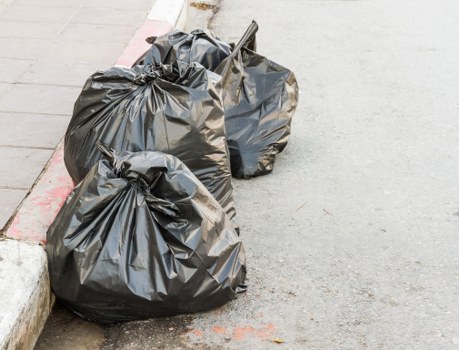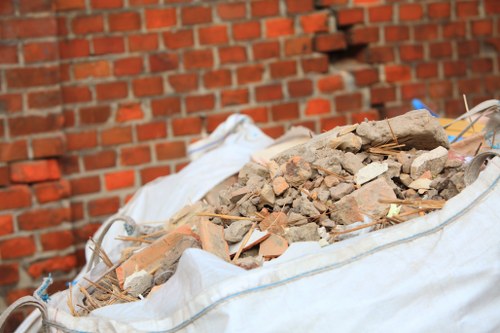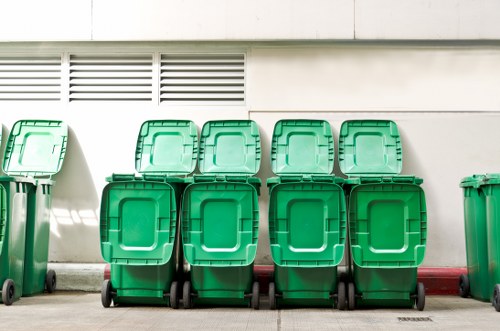Bulky Waste Collection in Flat Clearance
Understanding Bulky Waste Collection

Bulky waste collection is a specialized service aimed at removing large items that regular waste collection cannot handle. In the context of flat clearance, this service becomes essential, especially during moves, renovations, or when decluttering living spaces. Proper management of bulky waste ensures a clean and safe living environment, preventing potential hazards and maintaining hygiene.
Flats and apartments often have limited storage space, making it challenging to manage unwanted large items. From old furniture to broken appliances, these items need to be disposed of responsibly. Bulky waste collection services cater specifically to these needs, providing a streamlined solution for residents.
Moreover, improper disposal of bulky waste can lead to environmental issues. Items left unattended can contribute to pollution and attract pests, compromising the overall quality of life within the community. Therefore, efficient waste collection services play a crucial role in urban living.
The Importance of Professional Flat Clearance

Professional flat clearance services offer numerous benefits beyond mere waste removal. They ensure that items are disposed of in compliance with local regulations, reducing the risk of fines or legal issues for residents. Additionally, these services often include recycling options, promoting environmental sustainability by diverting waste from landfills.
Hiring experts for bulky waste collection ensures that the process is handled safely and efficiently. Trained personnel are equipped to manage heavy or awkward items, minimizing the risk of injury or damage to property. This level of expertise is particularly important in high-rise buildings where space constraints require careful maneuvering.
Another significant advantage is the time saved by residents. Clearing out bulky items can be time-consuming and physically demanding. Professional services take care of the heavy lifting, allowing residents to focus on other important tasks during their move or renovation.
Steps Involved in Flat Clearance

The flat clearance process typically involves several key steps to ensure thorough and efficient waste removal. Understanding these steps can help residents prepare and collaborate effectively with waste collection services.
1. Assessment and Planning: The first step involves assessing the volume and nature of the waste to be collected. This includes identifying items that need special handling or disposal methods. Planning ensures that the right resources and equipment are allocated for the job.
2. Sorting and Categorization: Items are sorted based on their type, material, and condition. Recyclable materials are separated from non-recyclable ones, and hazardous items are identified for specialized disposal.
Efficient Sorting Techniques

Efficient sorting techniques are vital in the flat clearance process. Proper categorization ensures that recyclable materials are processed appropriately, reducing the environmental impact of waste disposal.
Using clear labeling and designated areas for different waste types can streamline the sorting process. This method not only enhances efficiency but also minimizes the chances of cross-contamination between recyclable and non-recyclable materials.
Moreover, advanced sorting technologies can further improve the process. Automated systems can identify and separate materials with higher precision, speeding up the clearance process and ensuring compliance with environmental standards.
Benefits of Bulky Waste Collection Services

Utilizing professional bulky waste collection services offers numerous benefits to flat residents and the broader community. These advantages extend beyond just the removal of unwanted items.
- Environmental Protection: Proper disposal and recycling of bulky waste help protect the environment by reducing landfill usage and conserving natural resources.
- Health and Safety: Removing large debris prevents potential accidents and maintains a clean living space, promoting overall health and safety for residents.
- Convenience: Professional services handle all aspects of waste collection, saving time and effort for residents who might otherwise struggle with the process.
- Compliance: Ensuring that waste is disposed of according to local regulations helps residents avoid legal complications and fines.
Eco-Friendly Disposal Practices
Eco-friendly disposal practices are increasingly important in the realm of bulky waste collection. These practices focus on minimizing the environmental footprint of waste removal by emphasizing recycling, reuse, and responsible disposal methods.
Many waste collection services now prioritize items that can be recycled or repurposed. Furniture, electronics, and other large items are often donated to charities or recycled facilities, extending their lifecycle and reducing waste.
Additionally, promoting the use of biodegradable materials and reducing the reliance on landfills are key components of sustainable waste management. These efforts contribute to a healthier environment and a more sustainable future.
Choosing the Right Waste Collection Service
Selecting the appropriate bulky waste collection service is crucial for ensuring a smooth and efficient flat clearance process. Several factors should be considered to make an informed decision.
1. Reputation and Reliability: Research the reputation of waste collection companies by reading reviews and seeking referrals. A reliable service provider ensures timely and efficient waste removal.
2. Range of Services: Ensure that the service offers comprehensive solutions, including sorting, recycling, and disposal of various types of bulky waste.
3. Compliance with Regulations: The company should adhere to local waste disposal regulations and environmental standards, ensuring that waste is handled responsibly.
Cost-Effective Solutions
Cost is an important consideration when choosing a bulky waste collection service. It's essential to balance affordability with the quality of services provided.
Many companies offer flexible pricing structures based on the volume of waste, the type of items, and the level of service required. Comparing quotes from multiple providers can help residents find a service that fits their budget without compromising on quality.
Additionally, some services offer bundled packages for large-scale clearances, providing more value for money. These packages may include additional services such as deep cleaning or minor repairs to facilitate the clearance process.
Environmental Impact of Bulky Waste
Bulky waste, if not managed properly, can have significant negative impacts on the environment. Understanding these effects underscores the importance of effective waste collection and disposal practices.
Large items often contain materials that do not decompose easily, taking up valuable space in landfills. This not only accelerates the rate at which landfills reach capacity but also contributes to environmental degradation.
Furthermore, certain bulky items, such as electronics or treated wood, can release harmful substances into the soil and water if not disposed of correctly. This pollution can affect local ecosystems and pose health risks to nearby communities.
Recycling and Reuse Opportunities
Recycling and reuse present viable solutions to the challenges posed by bulky waste. By diverting waste from landfills, these practices help conserve resources and reduce environmental impact.
Recycling involves processing used materials to create new products, thereby extending their lifecycle. For example, old furniture can be refurbished, and electronics can be dismantled to recover valuable components.
Reuse, on the other hand, focuses on finding new uses for items that are still in good condition. Donating furniture or appliances to those in need not only helps reduce waste but also benefits the community.
Technological Advancements in Waste Collection
Advancements in technology have significantly enhanced the efficiency and effectiveness of bulky waste collection services. Modern tools and systems streamline operations, leading to better outcomes for both service providers and residents.
For instance, advanced scheduling software allows for optimized routing, reducing fuel consumption and operational costs. GPS tracking ensures that waste collection vehicles are efficient in their movements, minimizing delays and improving service reliability.
Moreover, innovative machinery and equipment enable the safe and efficient handling of heavy or oversized items. This technology reduces the risk of injury to workers and prevents damage to property during the clearance process.
Smart Waste Management Systems
Smart waste management systems utilize data and technology to enhance the overall waste collection process. These systems provide real-time information, enabling more informed decision-making and improving service quality.
IoT (Internet of Things) devices can monitor waste bins and alert service providers when they are full, ensuring timely pickups and preventing overflow. Additionally, data analytics help identify trends and optimize resource allocation, leading to more efficient operations.
These smart systems also facilitate better communication between service providers and residents. Residents can track the status of their waste collection requests, receive notifications, and provide feedback, fostering a more transparent and customer-centric service model.
Regulations and Compliance
Compliance with local and national regulations is a critical aspect of bulky waste collection. These regulations ensure that waste is handled in a manner that protects public health and the environment.
Regulatory frameworks often dictate how different types of waste should be disposed of, including specific guidelines for hazardous materials. Non-compliance can result in legal penalties, fines, and damage to a company's reputation.
Professional waste collection services stay updated with the latest regulations and ensure that all waste management practices adhere to legal standards. This adherence not only guarantees the safety and sustainability of the services provided but also instills confidence in residents relying on these services.
Best Practices for Residents
Residents play a vital role in the effectiveness of bulky waste collection. By following best practices, they can facilitate smoother operations and contribute to the overall success of waste management efforts.
Key best practices include:
- Proper Segregation: Separating recyclable and non-recyclable items helps streamline the sorting process and enhances recycling efforts.
- Scheduling in Advance: Planning waste collection in advance ensures that the service provider can allocate appropriate resources and avoid delays.
- Safe Packaging: Ensuring that items are securely packaged prevents damage during transportation and reduces the risk of injury.
- Collaborating with Service Providers: Clear communication with waste collection services about specific needs and constraints can improve the efficiency of the clearance process.
Eco-Friendly Practices for Flat Clearance
Embracing eco-friendly practices during flat clearance not only benefits the environment but also fosters a sense of responsibility and sustainability within the community.
Residents can adopt several strategies to make their flat clearance more environmentally friendly, such as:
- Donating Usable Items: Items that are still in good condition can be donated to charitable organizations, extending their lifecycle and reducing waste.
- Recycling Materials: Separating materials like metal, glass, and plastic allows for effective recycling and resource conservation.
- Minimizing Waste: Before clearing out, consider whether certain items can be repaired or repurposed, reducing the volume of waste.
- Choosing Sustainable Disposal Options: Selecting waste collection services that prioritize eco-friendly disposal methods ensures that waste is managed responsibly.
Community Involvement and Awareness
Building community awareness about the importance of proper bulky waste collection can lead to more effective and sustainable waste management practices. Educational initiatives and community programs can inform residents about best practices and the benefits of responsible waste disposal.
Local governments and waste collection companies can collaborate to host workshops, seminars, and informational campaigns. These efforts can highlight the environmental impact of waste, the importance of recycling, and the role of residents in maintaining a clean living environment.
Encouraging community involvement fosters a collective responsibility towards waste management, leading to improved compliance and participation in bulky waste collection efforts.
Future Trends in Bulky Waste Collection
The future of bulky waste collection is poised to be shaped by technological advancements, increasing environmental awareness, and evolving regulations. These trends will continue to enhance the efficiency and sustainability of waste management practices.
One significant trend is the integration of artificial intelligence and machine learning into waste management systems. These technologies can predict waste generation patterns, optimize collection schedules, and enhance sorting processes, leading to more efficient operations.
Another trend is the growing emphasis on circular economy principles. This approach focuses on designing waste out of the system by promoting reuse, repair, and recycling, thereby minimizing resource consumption and waste generation.
Innovations in Recycling Technologies
Innovations in recycling technologies are revolutionizing the way bulky waste is managed. Advanced machinery and processes enable more effective separation and processing of materials, increasing the rate of recycling and reducing environmental impact.
For example, automated sorting systems can now efficiently identify and separate different materials through techniques like optical sorting and magnetic separation. These technologies enhance the purity and quality of recycled materials, making them more suitable for reuse in manufacturing.
Additionally, chemical recycling methods are being developed to break down complex materials into their basic components, allowing for the creation of new products from previously unusable waste. These innovations contribute to a more sustainable and resource-efficient waste management system.
Conclusion
Bulky waste collection in flat clearance is an essential service that ensures the proper management and disposal of large household items. By adopting professional services, residents can benefit from efficient, safe, and environmentally responsible waste removal solutions.
Emphasizing eco-friendly practices, leveraging technological advancements, and fostering community involvement are key factors in enhancing the effectiveness of bulky waste management. As urban living continues to evolve, so too must the strategies and services that support sustainable and healthy living environments.
For a hassle-free and efficient bulky waste collection experience, contact us today and let our professional team assist you in maintaining a clean and clutter-free home.
Get Started with Your Flat Clearance
Ready to clear out those bulky items and reclaim your living space? Book your service now and let our experts handle the heavy lifting for you. With our dedicated team and eco-friendly practices, you can enjoy a seamless and responsible waste collection experience.
Don’t wait any longer—contact us today to schedule your flat clearance and take the first step towards a cleaner, more organized home.

